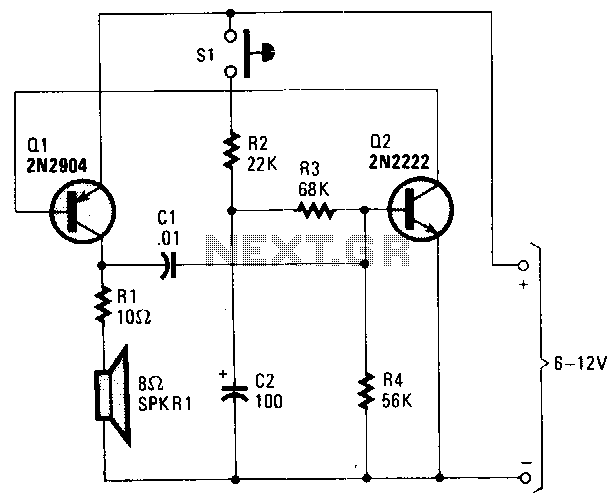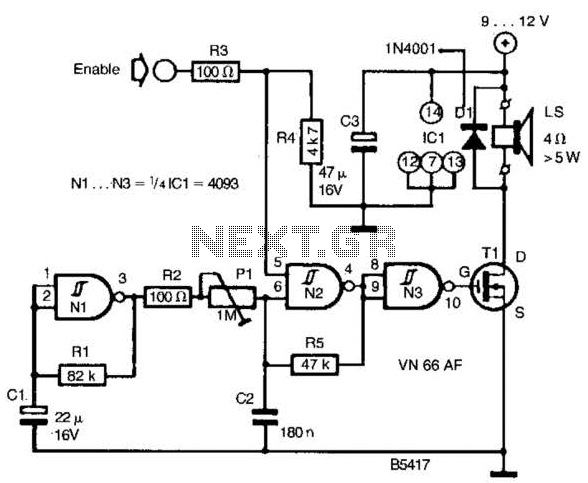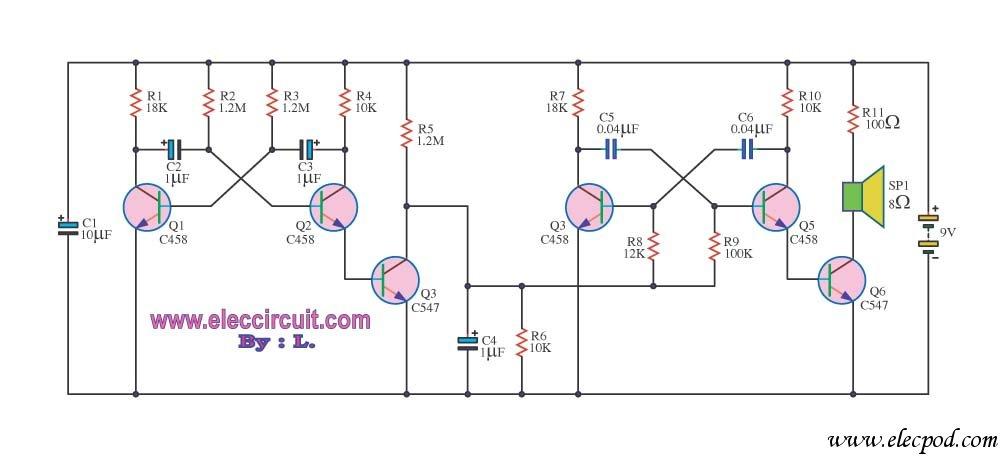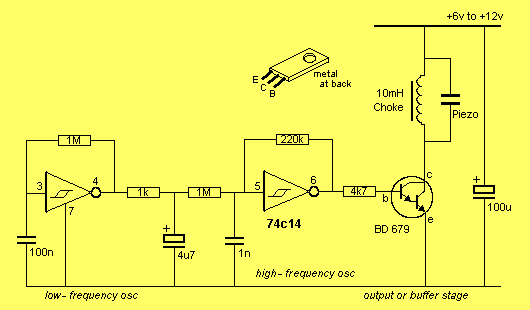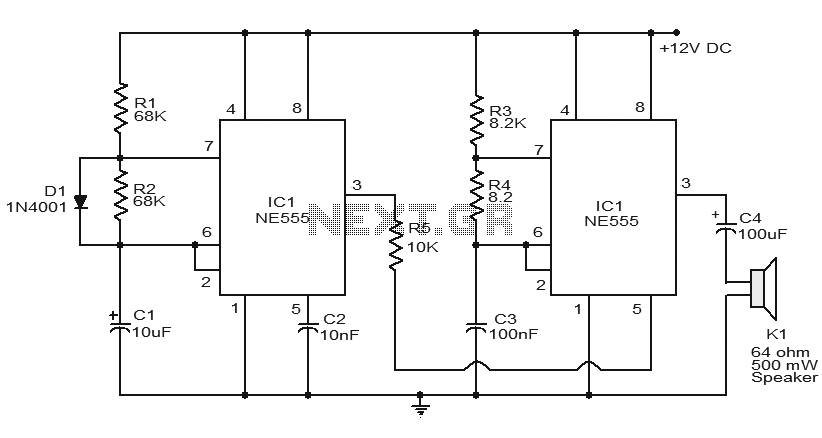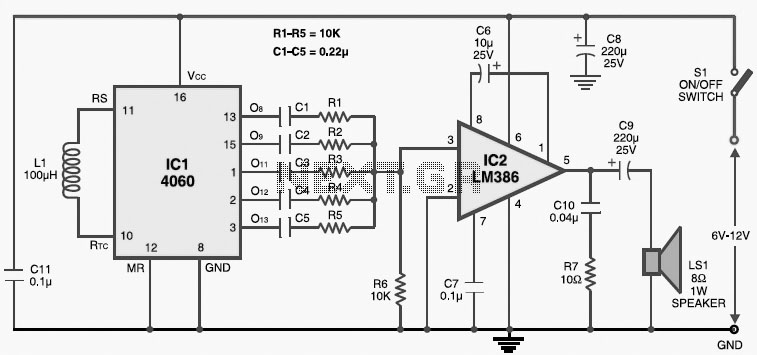
us style siren
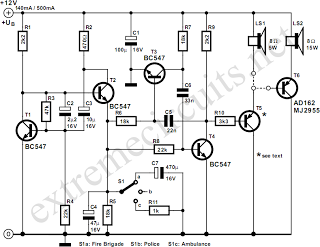
The circuit outlined here is capable of producing three distinct US-style siren sounds: police, ambulance, and fire engine. The sound selection is facilitated by switch S1. This circuit is applicable in various contexts, including toys (such as model vehicles), alarm systems, and other uses. For toy applications, a BC337 transistor serves effectively as driver T5, as it can directly drive a 200mW (8Ω) loudspeaker. In this scenario, the current draw from a 9V power supply is approximately 140mA. For applications requiring a louder sound, a BD136 transistor is advisable, as it can drive a 5W (8Ω) loudspeaker, resulting in a current consumption of about 180mA from a 12V supply. For even higher volume, T5 (a BD136) can be configured as a first driver stage, with a 15W (8Ω) loudspeaker connected through output transistor T6. Suitable options for T6 include the AD162 or MJ2955 transistors, which require adequate cooling for continuous operation. The peak current consumption of the circuit under these conditions will be around 500mA when powered by a 12V supply. Notably, capacitor C1 is unnecessary for battery operation.
The described siren circuit integrates a selection switch (S1) that allows users to choose between three distinct siren sounds. The circuit's functionality is primarily based on the transistor driver stages, where the choice of transistor influences the output power and sound volume.
In the initial configuration with a BC337 transistor as T5, the circuit is optimized for low-power applications, suitable for toys, where a 200mW loudspeaker can be effectively driven. The current consumption is modest, making it ideal for battery-operated devices. However, for applications demanding higher sound output, the BD136 transistor serves as a robust alternative, capable of driving a more powerful 5W loudspeaker. This configuration increases the current draw to 180mA from a 12V supply, ensuring louder siren sounds for applications such as alarm systems.
For scenarios requiring maximum sound output, the circuit can be expanded by incorporating an additional output stage using T6. This configuration allows the use of a 15W loudspeaker, significantly enhancing the audio output. The choice of transistors such as AD162 or MJ2955 for T6 is critical, as these components are designed to handle the increased current demands and require proper thermal management to avoid overheating during continuous operation.
The peak current consumption of approximately 500mA when utilizing a 12V power supply indicates that the circuit can deliver substantial audio power, making it suitable for various applications beyond toys, including security alarms and emergency signal systems. The design's flexibility in accommodating different loudspeaker ratings and power supplies allows for tailored implementations based on specific user requirements while ensuring reliable operation and sound quality. The absence of capacitor C1 in battery-powered configurations simplifies the design and reduces component count, enhancing overall efficiency.The circuit described here can create three different US-style` siren sounds: police, ambulance and fire engine. The desired sound can be selected using switch S1. The circuit can be used in toys (such as model vehicles), as part of an alarm system, and in many other applications.
For use in a toy, a BC337 is an adequate device for driver T5, sinc e it is capable of directly driving a 200mW (8) loudspeaker. In this case the current consumption from a 9 V power supply is around 140 mA. If a louder sound is required, a BD136 is recommended: this can drive a 5W (8) loudspeaker. The current consumption from a 12 V supply will then be about 180mA. If still more volume is desired, then T5 (a BD136) can be used as a first driver stage, and a 15W (8) loudspeaker can be connected via output transistor T6. Here an AD162 or an MJ2955 can be used, which, for continuous operation, must be provided with cooling.
The peak current consumption of the circuit will now be about 500mA with a 12V power supply. Capacitor C1 is not required for battery operation. 🔗 External reference
The described siren circuit integrates a selection switch (S1) that allows users to choose between three distinct siren sounds. The circuit's functionality is primarily based on the transistor driver stages, where the choice of transistor influences the output power and sound volume.
In the initial configuration with a BC337 transistor as T5, the circuit is optimized for low-power applications, suitable for toys, where a 200mW loudspeaker can be effectively driven. The current consumption is modest, making it ideal for battery-operated devices. However, for applications demanding higher sound output, the BD136 transistor serves as a robust alternative, capable of driving a more powerful 5W loudspeaker. This configuration increases the current draw to 180mA from a 12V supply, ensuring louder siren sounds for applications such as alarm systems.
For scenarios requiring maximum sound output, the circuit can be expanded by incorporating an additional output stage using T6. This configuration allows the use of a 15W loudspeaker, significantly enhancing the audio output. The choice of transistors such as AD162 or MJ2955 for T6 is critical, as these components are designed to handle the increased current demands and require proper thermal management to avoid overheating during continuous operation.
The peak current consumption of approximately 500mA when utilizing a 12V power supply indicates that the circuit can deliver substantial audio power, making it suitable for various applications beyond toys, including security alarms and emergency signal systems. The design's flexibility in accommodating different loudspeaker ratings and power supplies allows for tailored implementations based on specific user requirements while ensuring reliable operation and sound quality. The absence of capacitor C1 in battery-powered configurations simplifies the design and reduces component count, enhancing overall efficiency.The circuit described here can create three different US-style` siren sounds: police, ambulance and fire engine. The desired sound can be selected using switch S1. The circuit can be used in toys (such as model vehicles), as part of an alarm system, and in many other applications.
For use in a toy, a BC337 is an adequate device for driver T5, sinc e it is capable of directly driving a 200mW (8) loudspeaker. In this case the current consumption from a 9 V power supply is around 140 mA. If a louder sound is required, a BD136 is recommended: this can drive a 5W (8) loudspeaker. The current consumption from a 12 V supply will then be about 180mA. If still more volume is desired, then T5 (a BD136) can be used as a first driver stage, and a 15W (8) loudspeaker can be connected via output transistor T6. Here an AD162 or an MJ2955 can be used, which, for continuous operation, must be provided with cooling.
The peak current consumption of the circuit will now be about 500mA with a 12V power supply. Capacitor C1 is not required for battery operation. 🔗 External reference
